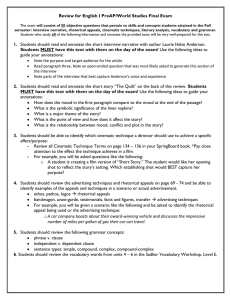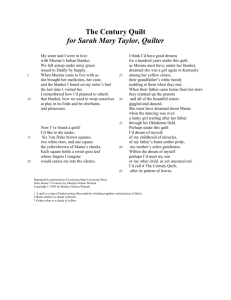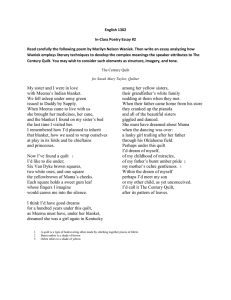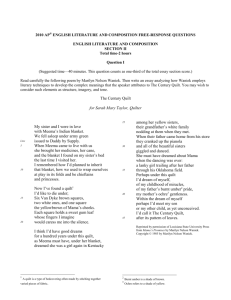English 1- On Level Semester Exam Review (1st Semester) Roots
advertisement
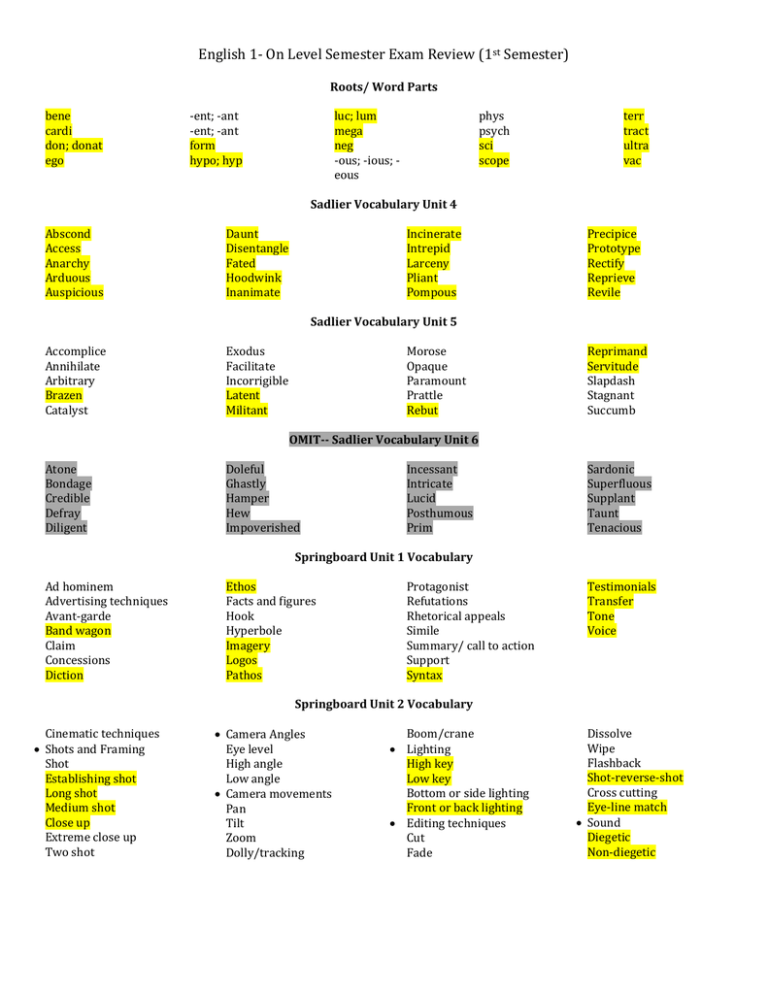
English 1- On Level Semester Exam Review (1st Semester) Roots/ Word Parts bene cardi don; donat ego -ent; -ant -ent; -ant form hypo; hyp luc; lum mega neg -ous; -ious; eous phys psych sci scope terr tract ultra vac Sadlier Vocabulary Unit 4 Abscond Access Anarchy Arduous Auspicious Daunt Disentangle Fated Hoodwink Inanimate Incinerate Intrepid Larceny Pliant Pompous Precipice Prototype Rectify Reprieve Revile Sadlier Vocabulary Unit 5 Accomplice Annihilate Arbitrary Brazen Catalyst Exodus Facilitate Incorrigible Latent Militant Morose Opaque Paramount Prattle Rebut Reprimand Servitude Slapdash Stagnant Succumb OMIT-- Sadlier Vocabulary Unit 6 Atone Bondage Credible Defray Diligent Doleful Ghastly Hamper Hew Impoverished Incessant Intricate Lucid Posthumous Prim Sardonic Superfluous Supplant Taunt Tenacious Springboard Unit 1 Vocabulary Ad hominem Advertising techniques Avant-garde Band wagon Claim Concessions Diction Ethos Facts and figures Hook Hyperbole Imagery Logos Pathos Protagonist Refutations Rhetorical appeals Simile Summary/ call to action Support Syntax Testimonials Transfer Tone Voice Springboard Unit 2 Vocabulary Cinematic techniques Shots and Framing Shot Establishing shot Long shot Medium shot Close up Extreme close up Two shot Camera Angles Eye level High angle Low angle Camera movements Pan Tilt Zoom Dolly/tracking Boom/crane Lighting High key Low key Bottom or side lighting Front or back lighting Editing techniques Cut Fade Dissolve Wipe Flashback Shot-reverse-shot Cross cutting Eye-line match Sound Diegetic Non-diegetic Sentence Parts Review 1. A __clause___________ is a group of words containing a subject and a predicate and forms part of a sentence. 2. The ___subject__________ of a sentence is the part about which something is being said. It is the doer of the action. 3. A ___phrase_________ is a group of related words not expressing a complete thought and without a subject and predicate. 4. A ___independent_________ clause contains a subject and a predicate and can stand alone as a simple sentence. 5. The __predicate__________ of a sentence is the part which says something about the subject. It expresses the action of the sentence. It tells what is being done. 6. A ____dependent______ clause depends on the rest of the sentence for its meaning. It does not express a complete thought and cannot stand alone. Phrase or Clause? __C__ What she said __C__ What you do __P__ Earning the money __P__ To the edge of the road __P__ With a good friend __C__ The curtain rose __C__ Time passes rapidly __P__ Constructing a dam __P__ The capital of Georgia __C__ If he feels like it Type of Clause: Dependent or Independent? Identify the type of clause underlined in each sentence. 1. As soon as we sat at the table, the waiter brought menus. __D___ 2. The children couldn’t finish the race, but the adults could easily. __I__ 3. If I wear my new shoes, I will get blisters. __I__ 4. When it rains, the field turns to mud. __D___ 5. You play the piano, and I will practice my singing. __I__ 6. I ate the whole pizza that my mom ordered. __I__ 7. I made the bed before the dance. __I__ 8. I can’t have dessert unless I eat my dinner. __D___ Sentence Types: Simple:___________________________________________________________________________________________ Compound:_______________________________________________________________________________________ Compound:_______________________________________________________________________________________ **There are two ways to create a compound sentence. You need to know how to join the independent clauses with a semicolon AND a coordinating conjunction. Complex:_________________________________________________________________________________________ Compound- Complex:_______________________________________________________________________________ Coordinating Conjunctions: joins words or groups of words that have equal grammatical weight in a sentence. F- _______for_____________________ B- _____________but_______________ A- ______and_____________________ O- _____________or________________ N- ______nor______________________ Y- _____________yet_______________ S- _____________so________________ Read the following interview narrative, annotate the passage, and answer the questions Who Wrote That? Featuring Laurie Halse Anderson Published in California Kids! (March 2005) Laurie Halse Anderson says that no one who knew her as a child thought she would become a successful adult. “I was an innocent child and wasn’t terribly bright. I stuttered and needed a reading tutor.” As a teen, she remembers feeling confused and overwhelmed most of the time and withdrew into herself for protection. In college, Anderson avoided English and language arts classes because she hated the way teachers made her analyze books. “This made the process of becoming an author A LOT harder!” she says. In spite of her lack of formal English training, Anderson possesses a well-developed sense of story. When she was a kid, she used to sneak downstairs after bedtime to eavesdrop on the grown-ups telling stories. Their tales not only grounded Anderson in her own history, but subliminally implanted literary devices like pacing, hooks, and dialogue. Before Anderson is ready to write a novel, she thinks about her main characters until she can hear their voices in her head. She calls this stage “eavesdropping” because she records what she hears—bits of dialogue, likes, dislikes, fears—all the nuances that make her characters real. As the characters develop, conflict points become clearer. Once Anderson establishes conflict, she begins writing. When Anderson first started writing for children, she had a day job. “I was sneaking in my writing in the morning and at night. Now that I’m a published author who’s had a lot of lucky breaks, I have a day job—designing my website, answering fan mail, speaking at schools and conferences. So I still sneak in my writing in the morning and at night.” But Anderson isn’t complaining. She feels fortunate to have had such an impact on children. If she had to predict how her life would have turned out, she would never have predicted her current success. 1. What is the purpose of this passage? 2. Who is the target audience? 3. What were some open ended questions the interviewer asked Anderson? 4. Why did Anderson become a writer? 5. Briefly describe the voice of the piece. Include ideas about diction, syntax, imagery and tone( the elements of voice) Read the following short story, annotate the passage, and answer the questions The Quilt The unpleasant sensations of feeling chilled from the weather and overheated and exhausted overtook Nettie. Although she searched the recesses of her mind, there was nothing to contemplate that would take her mind off her immense weariness. She felt as tattered as the worn clothes piled high in the mending basket. The laundry was backbreaking labor—all that water to carry and humongous iron pots to hoist onto the fire. The quilt was immersed and soaking in the kettle, waiting until Nettie had scrubbed the linen napkins. The napkins, which made Nettie smile momentarily, in spite of herself, were Mama's way of holding onto her family traditions of formality, no matter how ridiculous it might seem on the rough prairie. She always insisted that their mealtimes be observed with some decorum. No one from their family would wipe their dinner drippings on their sleeve. This seemed a frivolous practice to Nettie, her prairie-born child—Nettie, the one who invariably did the scrubbing. To her, Mama's tradition just meant more laundering—more water to carry, more kettles and pots to hoist, more scrubbing to numb and damage her hands. She yearned for an idyllic location where she could stretch out her back and melt away her aches in the sunshine. Daydreams of peaceful slumber clouded her mind. Mama roused her from her musings to help heave the quilt from the ancient kettle. Nettie watched as the steam escaped into the frosty October air, and her mother grabbed the two thick branches Papa had whittled and handed one to Nettie. "Now come on, child, and help me with this quilt. We've practically boiled it to death." Plunging the wooden branches into the kettle, Nettie and her mother maneuvered them under the quilt to haul the soaking mass out of the pot. Nettie staggered under the cumbersome weight of the quilt before regaining her balance, but Mama's feet were steady and sure; as always, this gave Nettie comfort. Mama may have been slight in stature, but she had the strength of a team of horses. Mama always gave the appearance of being hard and uncompromising, but her interior was nothing but softness—nothing but a loving and affectionate soul. Together they hefted the quilt and hung it on the clothesline, which nearly collapsed to the ground under its heavy burden. Why they needed that ancient quilt was a mystery. You would have thought Papa had discovered gold when he brought it home from the trading post, bursting into the cabin and practically flinging it at Mama. Mama's eyes were gleaming, and her smile transformed her face, removing all traces of hardship and leaving only radiance in its place. "Now, Oliver, I hope that's not the only thing you brought back." He affectionately kissed her cheek. "There's more in the wagon," he replied and then collapsed in the chair like the bucket dropping to the bottom of a well. "That pitiful quilt looks like a collection of discarded rags," Nettie heard herself say. "It's an heirloom, Nettie. After some mending and a thorough washing, this handsome quilt will be magnificent. You won't refer to it as a collection of rags when its encompassing folds shield you from the harsh winter winds and bitter cold," added Mama in mild reproach. Papa just laughed, finding humor in life's experiences as he always did; his was the way of the optimist, and he faced every day on the prairie as an adventure to be encountered gladly. Though the deep creases on his forehead told another story, Papa never indicated that he felt anything but lighthearted. "Nettie, quit fantasizing and grab an end so we can smooth this beauty out." Nettie's hands were a brilliant crimson, and they stung fiercely, but she took heed and helped Mama straighten the quilt. Water pooled into a murky puddle as it cascaded from the cloth. Nettie stepped away gingerly, not wanting to drench her shoes any further in the all-encompassing puddle forming under the quilt. That menacing puddle reminded her of what it felt like when she had to do the washing as if she were about to submerge herself into the deepest darkest depths, only to resurface when she had discovered some way to escape from the tedious task. She looked up, and there was the quilt suspended from the clothesline. For the first time she saw something other than a collection of patchwork rags. Instead, she saw beautiful depictions delicately embroidered in the patchwork: a tree in summer, boughs laden with an abundance of speckled apples; the dark silhouettes of horses at pasture against a sunset; a portrait of a young girl; waves of golden wheat blanketing fields. Nettie reached out and traced these pictures with her fingertips. Who knew it was so beautiful? No wonder Papa had borne it home in triumph; no wonder Mama had spent countless hours repairing and restoring it. When it was finally dry, that lovely old quilt would surround her in tenderness and warmth and protect her through all of the frigid prairie winter nights. No howling wind, no piercing cold could ever touch her again. 1. Complete a plot chart for the story. 2. From what point of view is the story told? 3. What is the predominate mood and tone of the piece? 4. What are some possible themes of the piece? 5. How does the main character change? 6. Pretend you are a director and have been asked to make a film version of this story. Where could you use the following techniques and why a. Eye line match b. long shot c. close up d. diegetic sound/nondiegetic sound e. lighting
